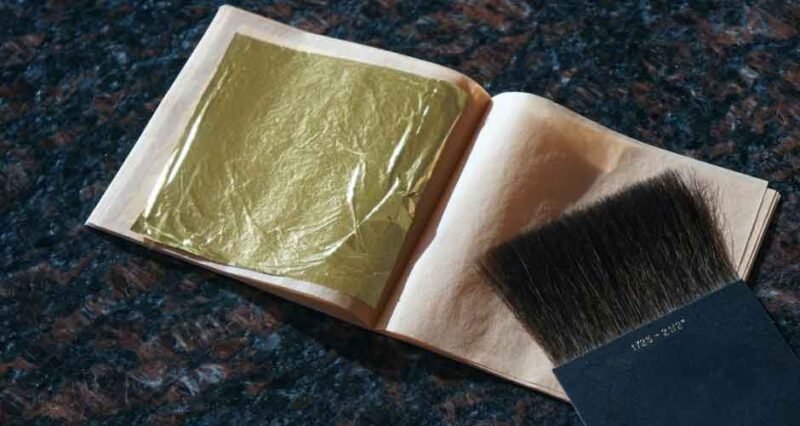
Introduction
Gold leaf gilding, a revered art form, has graced temples, palaces, and masterpieces for millennia. This delicate craft, which involves applying ultra-thin sheets of gold to surfaces, demands precision and patience. This guide offers a deep dive into the intricate world of gilding, ensuring you’re equipped to create your own golden masterpieces.
Historical Context of Gold Leaf Gilding
Gold leaf’s history spans ancient civilizations, from the Egyptians’ tombs to the Romans’ statues. Its allure lies not just in its opulence but in its ability to resist corrosion and tarnish. Understanding its historical significance can provide a deeper appreciation for the craft and its enduring appeal.
Understanding Genuine Gold Leaf
Genuine gold leaf is the epitome of luxury and craftsmanship. Produced by hammering gold into tissue-thin sheets, its purity distinguishes it from imitation variants. Genuine gold leaf in multiple karats offers a radiant sheen unmatched by alloyed alternatives. Its allure isn’t just visual; genuine gold leaf doesn’t tarnish, ensuring longevity.
Tools and Materials Needed
Gilding requires specialized tools:
Gilder’s Brush: Soft-bristled and wide, it’s designed to lift the fragile gold leaf without tearing.
Gilder’s Cushion & Knife: Essential for cutting the leaf into desired sizes.
Materials: Apart from the gold leaf, you’ll need adhesive (size) to bond the gold to the surface, and a sealer to protect the finished work.
Safety Precautions
While gilding is relatively safe, it’s essential to work in a well-ventilated area, especially when using oil-based sizes or sealers. Wearing gloves can prevent potential skin reactions and also protect the delicate gold leaf from the oils on your skin. Always read and follow manufacturer’s instructions for any products used.
Preparing the Surface
Surface preparation is paramount. The substrate, whether wood, metal, or canvas, must be smooth and free from contaminants. Sanding is often the first step, especially for wooden surfaces, followed by cleaning with a lint-free cloth. Some surfaces benefit from a primer or base coat, which provides a uniform color background, enhancing the gold’s radiance.
Applying Adhesive
Size, a special adhesive for gold leaf, varies in composition. Water-based size dries quickly, ideal for small projects. Oil-based size, with a longer drying time, is preferred for large surfaces. Once applied, there’s a critical ‘tack’ window—neither too wet nor too dry—when the gold leaf should be applied for optimal adhesion.
Laying the Gold Leaf
The act of laying gold leaf, or gilding, is meditative. Using the gilder’s brush, gently lift the gold leaf and lay it onto the tacky surface. Overlapping edges ensure complete coverage. While the process requires a gentle touch, don’t be disheartened by minor tears or wrinkles; they often add character and authenticity to the finished piece.
Burnishing and Polishing
After gilding, burnishing compacts the gold, enhancing its sheen. Using a smooth, rounded tool, often crafted from agate or polished stone, gently rub the gold surface. This action smoothens out imperfections and imparts a mirror-like finish. For areas with intricate designs, specialized burnishers, shaped to access nooks and crannies, are invaluable.
Troubleshooting Common Issues
Mistakes happen, but they’re often salvageable:
Wrinkles/Tears: Overlay with a patch of gold leaf.
Missed Spots: Reapply size and patch with gold leaf.
Excess Adhesive: Before it dries, gently blot with a soft cloth.
Exploring Variations: Silver, Copper, and Other Metal Leafs (90 words)
While gold is the most renowned, other metals like silver, copper, and aluminum are also used in leaf form. Each offers a unique aesthetic and comes with its own set of considerations. For instance, silver leaf can tarnish and might require additional protective measures.
Caring for Gilded Objects
Maintaining the luster of gilded objects is crucial. Regular dusting with a soft brush or cloth can prevent buildup. Avoid abrasive cleaners, which can scratch or wear away the gold. For outdoor gilded objects, periodic resealing might be necessary to protect against the elements.
Conclusion
Gold leaf gilding, with its rich history and timeless appeal, transforms the mundane into the magnificent. As you hone your skills, remember that each piece, imperfect and radiant, is a testament to the enduring allure of gold.

